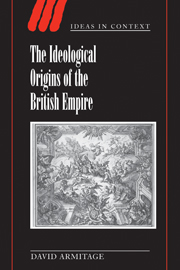Book contents
- Frontmatter
- Contents
- Acknowledgements
- 1 Introduction: state and empire in British history
- 2 The empire of Great Britain: England, Scotland and Ireland c. 1542–1612
- 3 Protestantismand empire: Hakluyt, Purchas and property
- 4 The empire of the seas, 1576–1689
- 5 Liberty and empire
- 6 The political economy of empire
- 7 Empire and ideology in the Walpolean era
- Bibliography
- Index
- Ideas in context
3 - Protestantismand empire: Hakluyt, Purchas and property
Published online by Cambridge University Press: 06 July 2010
- Frontmatter
- Contents
- Acknowledgements
- 1 Introduction: state and empire in British history
- 2 The empire of Great Britain: England, Scotland and Ireland c. 1542–1612
- 3 Protestantismand empire: Hakluyt, Purchas and property
- 4 The empire of the seas, 1576–1689
- 5 Liberty and empire
- 6 The political economy of empire
- 7 Empire and ideology in the Walpolean era
- Bibliography
- Index
- Ideas in context
Summary
To plant Christian religion without conquest, will bee hard.
Trafficke easily followeth conquest: conquest is not easie.
Trafficke without conquest seemeth possible, and not uneasie.
What is to be done, is the question.
Protestantism should have been the solvent of difference within the Three Kingdoms, and hence the solution to the problem of diversity within the empire of Great Britain. The English proponents of Anglo- Scottish union in the 1540s, and their Scottish agents, argued that together the two kingdoms of England and Scotland could be joined to create a single Protestant island. The imposition of a post-Reformation conception of an Anglo-British empire could thereby extend the process of the Anglo-Welsh union to join another partly Celtic dominion to the English state, and thus form an insular bulwark against Roman Catholicism. Similarly, the New English settlers in Ireland argued from the 1560s that the extension of Protestantism could secure Ireland against invasion and even bring the Kingdom of Ireland into an archipelagic Protestant triumvirate. The integrative force of Protestantism could potentially serve as the bond of union between the civilised inhabitants of the Three Kingdoms to create a uniquely post-Reformation territorial and jurisdictional empire.
The judgments of later historians have followed the contours of these arguments for Protestant integration, as the ideological origins of English nationalism, British nationhood and, in turn, British imperialism have all been traced back to the Protestant Reformations in England and Scotland.
- Type
- Chapter
- Information
- The Ideological Origins of the British Empire , pp. 61 - 99Publisher: Cambridge University PressPrint publication year: 2000
- 2
- Cited by



